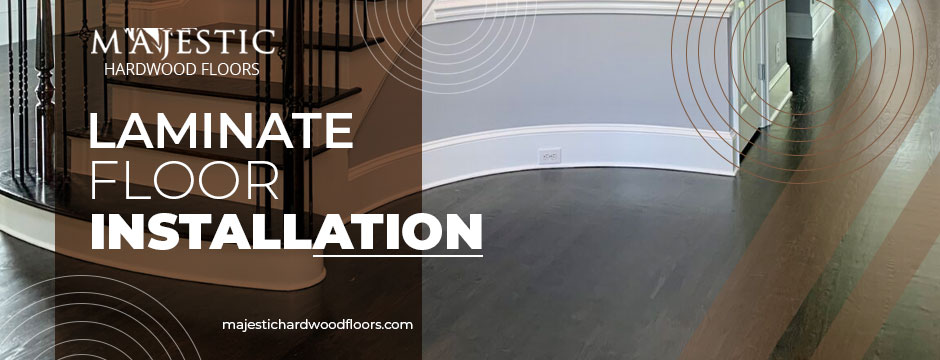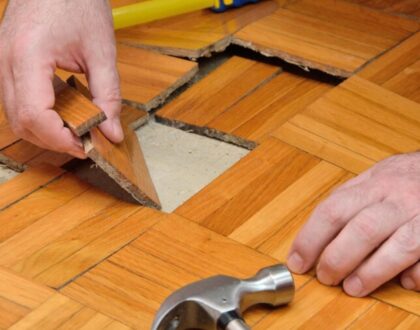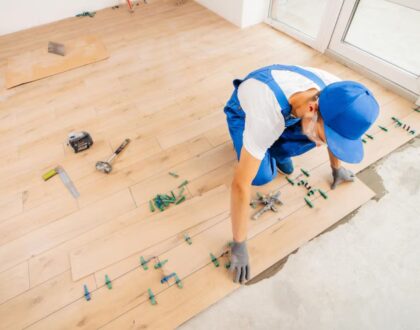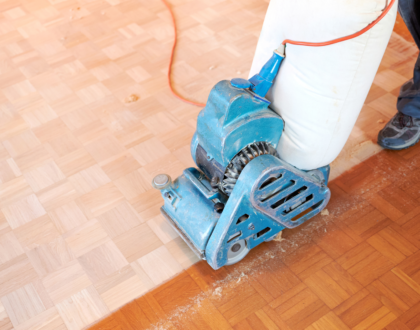Laminate Floor Installation for High-Traffic Areas: Ensuring Durability and Longevity

Laminate flooring is an excellent choice for high-traffic areas in both residential and commercial spaces. Its durability, affordability, and aesthetic appeal make it a popular flooring option. This comprehensive guide will walk you through the essential considerations and techniques for laminate floor installation in high-traffic areas. By following these guidelines, you can ensure that your laminate flooring withstands the demands of frequent foot traffic while maintaining its durability and longevity.
Understanding Laminate Flooring for High-Traffic Areas
Laminate flooring is a synthetic flooring material composed of several layers that are fused together. It typically consists of a high-density fiberboard (HDF) core, a photographic layer that mimics the appearance of wood or other materials, and a protective wear layer. This type of flooring offers numerous advantages for high-traffic areas, including durability, scratch resistance, easy maintenance, and a wide range of design options. When choosing laminate flooring for high-traffic areas, factors such as durability rating, thickness, wear layer, and color selection should be carefully considered.

Selecting the Right Laminate Flooring
Durability Rating and AC Rating: The durability rating, indicated by the AC rating, determines the flooring’s resistance to wear and tear. It is crucial to select laminate flooring with an appropriate AC rating for high-traffic areas.
Thickness and Density: Thicker and denser laminate flooring tends to be more durable and better equipped to handle heavy foot traffic. Choosing a suitable thickness and density is essential for long-lasting performance.
Wear Layer and Surface Finish: The wear layer acts as a protective barrier against scratches and stains. Opt for laminate flooring with a robust wear layer and a durable surface finish to ensure resistance to wear and maintain its appearance over time.
Choosing Appropriate Colors and Patterns: Select colors and patterns that can effectively hide dirt, scratches, and signs of wear. Consider laminate flooring options that closely resemble natural wood or stone, as they are known for their timeless appeal.
Preparing the Subfloor
Subfloor Inspection and Repair: Thoroughly inspect the subfloor for any unevenness, damage, or moisture issues. Repair any problems before installing laminate flooring to ensure a stable and level surface.
Moisture Barrier Installation: To protect laminate flooring from moisture-related issues, install a moisture barrier, such as a plastic sheet or underlayment with a built-in vapor barrier. This step is crucial, especially in areas prone to moisture, such as kitchens or bathrooms.
Acclimation Period for Laminate Flooring: Allow the laminate flooring to acclimate to the room’s temperature and humidity levels before installation. This step helps prevent issues such as warping or buckling after laminate floor installation.
Installation Techniques for High-Traffic Areas
- Proper Underlayment Installation
Install an appropriate underlayment to provide cushioning, absorb sound, and create a moisture barrier between the subfloor and laminate flooring. Follow manufacturer recommendations for underlayment selection and installation.
- Adhesive and Floating Installation Methods
Laminate flooring can be installed using either adhesive or floating methods. The choice depends on the specific product and manufacturer’s guidelines. Follow the recommended installation technique for optimal results.
- Adhesive and Floating Installation Methods
Laminate flooring can be installed using either adhesive or floating methods. The choice depends on the specific product and manufacturer’s guidelines. Follow the recommended installation technique for optimal results.
- Expansion Gaps and Transition Strips
Leave an expansion gap around the perimeter of the room to accommodate the natural expansion and contraction of laminate flooring. Install appropriate transition strips to create seamless transitions between different flooring materials or rooms.
- Undercutting Door Jambs for Seamless Transitions
To achieve a professional and polished look, undercut door jambs and casings to allow the laminate flooring to fit snugly underneath. This technique ensures a seamless transition and avoids awkward gaps or height differences.
Protective Measures for High-Traffic Laminate Floors
- Using Floor Protectors and Area Rugs
Place floor protectors under furniture legs to prevent scratching and indentations. Additionally, strategically place area rugs or runners in high-traffic pathways to further protect the laminate flooring.
- Regular Cleaning and Maintenance Practices
Implement a regular cleaning routine to remove dirt, dust, and debris from the surface. Use a microfiber mop or a vacuum cleaner with a soft brush attachment. Avoid excessive moisture during cleaning to prevent water damage.
- Avoiding Excessive Moisture Exposure
Laminate flooring is susceptible to moisture damage, so it is crucial to quickly clean up spills and avoid excessive water exposure. Use a damp (not wet) mop or cloth for cleaning and promptly dry any moisture on the surface.
- Managing Direct Sunlight and UV Protection
Direct sunlight can cause fading and discoloration of laminate flooring over time. Utilize window coverings, such as blinds or curtains, to limit direct sunlight exposure and protect the flooring from harmful UV rays.
Repair and Maintenance Tips
- Addressing Minor Scratches and Scuffs: Use a laminate floor repair kit or specialized markers to conceal minor scratches and scuffs. Follow the manufacturer’s instructions for the specific repair product.
- Dealing with Damaged or Loose Planks: If a laminate plank becomes damaged or loose, it can be replaced individually. Carefully remove the damaged plank and replace it with a new one following proper installation techniques.
- Proper Cleaning Techniques for Laminate Flooring: Avoid using harsh chemicals, abrasive cleaners, or excessive water when cleaning laminate flooring. Stick to manufacturer-recommended cleaning products and techniques to preserve the integrity of the flooring.
- Professional Maintenance and Restoration Services: If the laminate flooring experiences significant damage or wear, consider hiring professional maintenance and restoration services. These experts can assess the condition of the flooring, perform necessary repairs, and restore its original appearance.

Enhancing Longevity: Prevention and Care
- Implementing a No-Shoes Policy: Encourage family members, guests, and employees (in commercial spaces) to remove their shoes at the entrance to prevent dirt, gravel, and abrasive particles from scratching and damaging the laminate flooring.
- Spill and Stain Prevention Measures: Promptly clean up spills and stains to prevent them from penetrating the wear layer and causing permanent damage. Use manufacturer-approved cleaning products and techniques for specific stain removal.
- Furniture Pads and Proper Weight Distribution: Attach furniture pads or felt sliders to the bottom of furniture legs to prevent scratches and dents. Ensure that heavy furniture is evenly distributed to avoid excessive pressure on specific areas of the laminate flooring.
- Regular Inspections and Timely Repairs: Periodically inspect the laminate flooring for any signs of damage, wear, or loose planks. Address issues promptly to prevent further deterioration and extend the lifespan of the flooring.
Conclusion
Installing laminate flooring in high-traffic areas requires careful consideration and precise installation techniques. By selecting the right laminate flooring, preparing the subfloor adequately, and following recommended installation practices, you can ensure the durability and longevity of your laminate floors. Implementing protective measures, regular maintenance, and prompt repairs will further enhance the performance and appearance of the flooring. Remember to prioritize prevention and care by implementing policies such as a no-shoes rule, using furniture pads, and promptly addressing spills and stains. With proper laminate floor installation and proactive maintenance, your laminate flooring will withstand the demands of high-traffic areas and provide you with beautiful, long-lasting flooring for years to come.
To learn more, visit us at Majestic Hardwood Flooring!
Recent Posts

Expert Hardwood Repair Services at Your Fingertips
May 28, 2024


